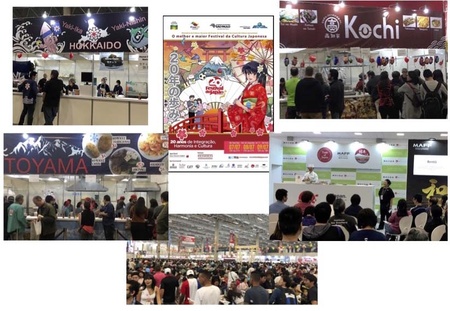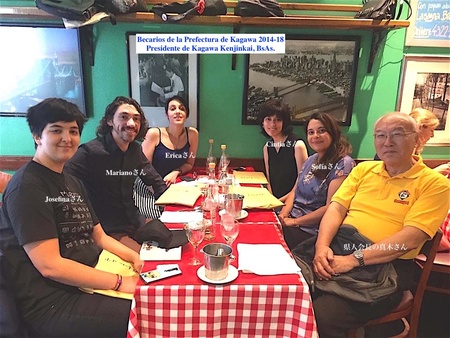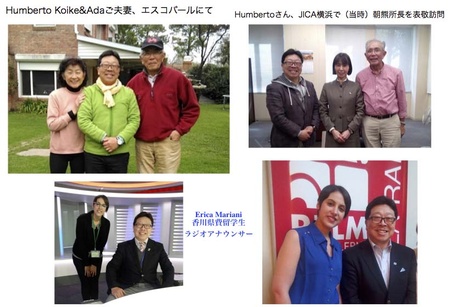In recent years, the form and role of "kenjinkai," which was a tool for communication between Japanese immigrants in South America and their prefectures of origin, has changed. Before the war, it was a place where people from the same hometown gathered to exchange limited information, and was an institution that acted as a bridge to contact families left behind. After the war, the number of kenjinkai operated with subsidies from each prefecture increased, and especially from the 1970s to the 1990s, when Japan became an economic superpower, some kenjinkai used subsidies from each prefecture to support short-term training for second and third generation Japanese, foster agricultural successors, and medium-term study abroad, as well as support elderly immigrants returning to their hometowns and organize exchange programs for young people from their prefectures to South America. In the immigrant destinations, whether in rural or urban areas, kenjinkais helped their fellow members and promoted friendship.
According to statistics from JICA and researchers, 650,000 Japanese people migrated to the Americas, including Hawaii, before the war alone. By prefecture, the top three were Hiroshima (96,848), Okinawa (72,227), Kumamoto (68,245), Fukuoka (51,240), Yamaguchi (45,223), Wakayama (30,980), Fukushima (25,923), Hokkaido (22,674), Okayama (20,839), Nagasaki (19,331), Niigata (15,633), and Kagoshima (14,085). After the war, more than 70,000 people emigrated overseas, mainly to South America, including Okinawa Prefecture (7,227), Tokyo (6,002), Fukuoka (4,536), Kumamoto (4,454), Hokkaido (4,487), Nagasaki (3,877), Kochi (2,723), Kagoshima (2,618), Fukushima (2,616), and Kanagawa Prefecture (2,364) .1
Brazil, which currently has 1.8 million Japanese descendants, is the only country where there are prefectural associations representing all 47 prefectures. The country also has an organization called the Prefectural Associations Federation, which plans and holds the world's largest Japanese Culture Festival, Festival do Japao, every year2 . Peru, Argentina, and Bolivia have many immigrants from Okinawa, and the Okinawa Prefectural Associations have their own halls and facilities, and hold a variety of events and exchange programs3 . In all countries, prefectural associations are undergoing a generational change, with young third-generation Japanese who do not have a high level of Japanese language ability now becoming involved in running the associations. As a result, the nature of prefectural associations is also changing.

The Japanese community in Argentina is thought to currently number around 50,000. During my childhood, it was around half that number, with around 30 members in the Kagawa Prefectural Association, the prefecture where my parents were from.4 Incidentally, 168 households and 403 people emigrated from Kagawa to Brazil after the war, followed by Paraguay with 33 households and 139 people. Most of the members were agricultural workers, and many delicious dishes were prepared for the annual New Year's party. We built friendships over Argentine asado (a charcoal-grilled beef barbecue), and there was quite a lot of interaction between us children.
From the mid-1970s to the 1990s, each prefecture actively provided training opportunities for the children of their own prefectures through overseas prefectural associations, and promoted exchanges with Asian countries and sister cities. However, nowadays, due to the prefectural financial situation, the number of young people of Japanese descent recommended as scholarship students has decreased, and some prefectures have reduced or abolished the prefectural scholarship program for Japanese descent5 .
According to the "History of Kagawa Prefecture's Migration to South America," the "Prefecturally Sponsored Study Abroad Program for Japanese Descendants," which began in 1972, is still in place to this day, but records show that no Argentinean children of Kagawa Prefecture have used the program since 2003. This is because there are so few children of Argentineans from Kagawa Prefecture who are no longer willing to recommend young people, and the available slots could no longer be utilized.
In light of this situation, in 2014, the Kagawa Prefectural Association, at the suggestion of its chairman, Sanagi Nobuaki, who runs a trading company in Buenos Aires, decided to recommend graduates of the Buenos Aires Nichia Gakuin who are interested in studying Japanese, studying Japanese, and wanting to receive training in Japan, regardless of whether they are of Japanese descent or not, and to send them as prefecturally funded students6. The first trainee was radio announcer Erika Mariani, who is of non -Japanese descent7. From July to December 2014, she received technical training in announcers and program production at Nishinippon Broadcasting in Takamatsu City. She said that it was a very valuable experience for her, as she was also exposed to Japanese culture. Drawing on these experiences, she is currently a personality on the Buenos Aires radio program "JAPON HOY (Japan Now) 8 " with second-generation Japanese Ricardo Tonoshima, and is actively involved in the activities of the Kagawa Prefectural Association, working hard to foster non-Japanese international students. When the Governor or prefectural assembly members from Kagawa Prefecture visit Argentina, they act as hosts in Japanese, much to the delight of prefectural officials. Even though they are not of Japanese descent, they stand out as they are more fluent in Japanese than Japanese people. In any case, the current Nikkei generation's efforts are aimed at revitalizing exchanges between their own society and the prefecture through the activities of the prefectural association, and it seems that their goal is to nurture human resources, including non-Nikkei, who will continue to contribute in the future.

This innovative idea of sending young non-Japanese people with no connection to the prefecture to study in Kagawa Prefecture is worthy of praise. Kagawa Prefecture-sponsored students are selected and recommended by Maki, the chairman of the Kagawa Prefectural Association, and the faculty of Nichia Academy. I hope that the children of the Kagawa Prefectural Association will not be left behind by non-Japanese people and will also take on the challenge of being recommended as international students or trainees.9 As far as I know, no other Kagawa Prefectural Association has undertaken such a new and innovative initiative that includes non-Japanese people.
As for Argentina, only the Ibaraki and Hyogo Prefectural Associations know about it, but the president of the Ibaraki Prefectural Association is a senior of mine from Escobar City, Buenos Aires Province, where I was born and raised, Humberto Koike (in his 70s, he was the manager of the Japanese baseball team that I played for when I was active), and he supports short-term visit programs to Argentina for high school and university students from the prefecture. Although he does not have perfect Japanese language skills himself, he continues to play a role as a bridge between the prefecture and the prefecture by regularly visiting the prefectural office and cooperating with the prefecture's exchange programs. In order to continue the study abroad program for Japanese descendants, he recommends as many capable young Japanese descendants as possible who will be beneficial to both countries in the future. And the president of the Hyogo Prefectural Association, Cristian Yamada (a very active young man in his 30s), who lives in Buenos Aires and came to Japan last year as a JICA Japanese descendant trainee, is also doing similar activities. With the number of Japanese descendants eligible to study in Japan decreasing in small prefectural associations in every country, these attempts are very instructive.

In Japan, there is a term called "regional revitalization," and revitalizing depopulated farming villages, municipalities, and declining local industries has become such a major issue that 10 ministers have been appointed to handle it. From this perspective, overseas prefectural associations can play a role in public relations, and are expected to play a certain role as vanguards in developing new markets.
In fact, the "Japanese Culture Festival" in Brazil mentioned at the beginning is seen as a big business opportunity for prefectures and other organizations. Approximately 200,000 people visit this three-day festival, the majority of whom are non-Japanese. Each prefectural association sets up a booth over the three days, introduces the prefecture's specialties and local cuisine, and sells some of the dishes as menu items, with the proceeds allocated to the prefectural association's operating expenses. Cooperating prefectures send English pamphlets and samples to the prefectural associations, and not only prefectural officials but also the Ministry of Agriculture, Forestry and Fisheries (e.g. promoting Wagyu beef) and corporate representatives (e.g. Japanese sake) travel to São Paulo. Sometimes they even hold seminars.
By recognizing these needs, Japanese people can make more effective use of the prefectural associations. Differences in language, culture, business practices, and the many regulations may mean that things don't always go as expected, but by recognizing new needs from both the younger generation of Japanese people and the prefectural government and approaching each other with expectations, it is believed that the role of the association as a "bridge" can be valuable in deepening exchanges as much as possible.
Notes:
1. Japan International Cooperation Agency, Overseas Migration Statistics, 1994; Yuki Ishikawa, Geographical Studies of Japanese Immigrants, 1997.
2.The website explains the organization's purpose and organizational structure in Japanese as well.
3. Association of Okinawans in Peru
Centro Okinawense en la Argentina
Colonia Okinawa, the Okinawan settlement in Santa Cruz, Bolivia
4. According to the 1990 "Kagawa Prefecture Postwar Emigrants by Year," there were 22 Argentine families, totaling 37 people (Source: Kagawa Prefecture South American Emigration History, p. 412, Kagawa Prefecture, 2004). Most of them lived in the suburbs of Buenos Aires, with a few families living in the provinces of Mendoza, Misiones, and Cordoba.
5. In some prefectures, only trainees who were favored by relatives or associates of the prefectural association presidents were recommended as international students, and the recruitment and selection methods were unclear, so young people with ambition were not being selected. Also, in the 1990s, there were cases where international students had bad behavior in Japan and caused trouble.
6. Nichia Gakuin was originally a Japanese language school only for people of Japanese descent, but in 1984 it was approved as a regular school by the Argentine Ministry of Education that provides integrated education from kindergarten through to high school, and as a result, the number of non-Japanese students has increased. It also offers a full range of Japanese and English classes, and from 2021 will offer higher education (as a vocational school) in Japanese language and Japanese culture.
7. Erica Mariani is currently 31 years old. She graduated from the Argentine National School of Announcers and has a license to be a TV and radio announcer. She also studied Japanese at Nichia Academy, has passed the Japanese Language Proficiency Test N2 level, and is working hard to pass N1. She hosts the radio program "JAPON HOY" as well as numerous Japanese cultural events in the Japanese community, and is also a Japanese language instructor at La Matanza National University.
8. " JAPOON HOY " is an FM radio program broadcast in Buenos Aires, and is produced with the help of sponsors. It was launched in 2008 and is still running today. It promotes Japanese cultural events and features people with ties to Japan. It airs every Wednesday at 5pm for an hour and can be accessed via the internet and YouTube. I appear on the program whenever I visit my hometown, but I also sometimes respond by phone interview when a major event or disaster occurs in Japan.
9. Japanese descendants from Latin America and the Caribbean can apply not only for prefectural training programs but also for the JICA Japanese Descendants Training Program and the Ministry of Education, Culture, Sports, Science and Technology's study abroad program, but in recent years many Japanese descendants have been coming to Japan through JICA's specialized programs .
10. As of March 2020, the Minister of State for Special Missions in the Cabinet Office is Seigo Kitamura, a member of parliament from Nagasaki.
© 2020 Alberto J. Matsumoto






